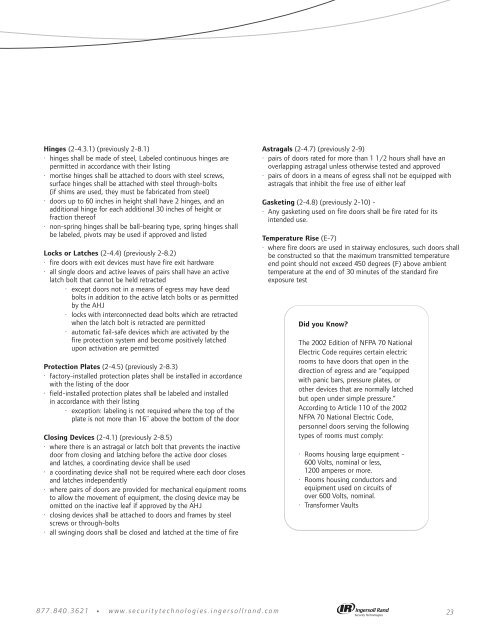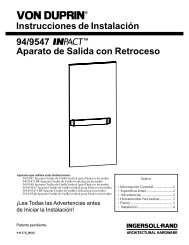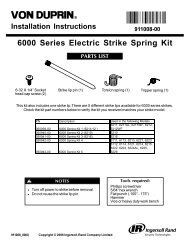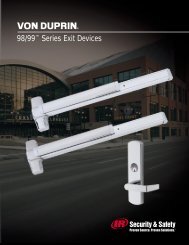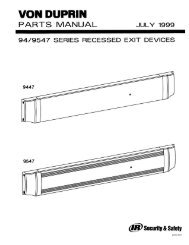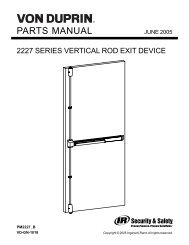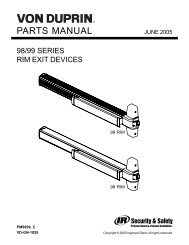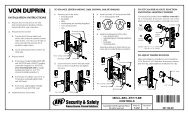Fire, Life Safety & Accessibility Codes - Von Duprin
Fire, Life Safety & Accessibility Codes - Von Duprin
Fire, Life Safety & Accessibility Codes - Von Duprin
You also want an ePaper? Increase the reach of your titles
YUMPU automatically turns print PDFs into web optimized ePapers that Google loves.
Hinges (2-4.3.1) (previously 2-8.1)<br />
· hinges shall be made of steel, Labeled continuous hinges are<br />
permitted in accordance with their listing<br />
· mortise hinges shall be attached to doors with steel screws,<br />
surface hinges shall be attached with steel through-bolts<br />
(if shims are used, they must be fabricated from steel)<br />
· doors up to 60 inches in height shall have 2 hinges, and an<br />
additional hinge for each additional 30 inches of height or<br />
fraction thereof<br />
· non-spring hinges shall be ball-bearing type, spring hinges shall<br />
be labeled, pivots may be used if approved and listed<br />
Locks or Latches (2-4.4) (previously 2-8.2)<br />
· fire doors with exit devices must have fire exit hardware<br />
· all single doors and active leaves of pairs shall have an active<br />
latch bolt that cannot be held retracted<br />
· except doors not in a means of egress may have dead<br />
bolts in addition to the active latch bolts or as permitted<br />
by the AHJ<br />
· locks with interconnected dead bolts which are retracted<br />
when the latch bolt is retracted are permitted<br />
· automatic fail-safe devices which are activated by the<br />
fire protection system and become positively latched<br />
upon activation are permitted<br />
Protection Plates (2-4.5) (previously 2-8.3)<br />
· factory-installed protection plates shall be installed in accordance<br />
with the listing of the door<br />
· field-installed protection plates shall be labeled and installed<br />
in accordance with their listing<br />
· exception: labeling is not required where the top of the<br />
plate is not more than 16˝ above the bottom of the door<br />
Closing Devices (2-4.1) (previously 2-8.5)<br />
· where there is an astragal or latch bolt that prevents the inactive<br />
door from closing and latching before the active door closes<br />
and latches, a coordinating device shall be used<br />
· a coordinating device shall not be required where each door closes<br />
and latches independently<br />
· where pairs of doors are provided for mechanical equipment rooms<br />
to allow the movement of equipment, the closing device may be<br />
omitted on the inactive leaf if approved by the AHJ<br />
· closing devices shall be attached to doors and frames by steel<br />
screws or through-bolts<br />
· all swinging doors shall be closed and latched at the time of fire<br />
877.840.3621 • www.securitytechnologies.ingersollrand.com<br />
Astragals (2-4.7) (previously 2-9)<br />
· pairs of doors rated for more than 1 1/2 hours shall have an<br />
overlapping astragal unless otherwise tested and approved<br />
· pairs of doors in a means of egress shall not be equipped with<br />
astragals that inhibit the free use of either leaf<br />
Gasketing (2-4.8) (previously 2-10) -<br />
· Any gasketing used on fire doors shall be fire rated for its<br />
intended use.<br />
Temperature Rise (E-7)<br />
· where fire doors are used in stairway enclosures, such doors shall<br />
be constructed so that the maximum transmitted temperature<br />
end point should not exceed 450 degrees (F) above ambient<br />
temperature at the end of 30 minutes of the standard fire<br />
exposure test<br />
Did you Know?<br />
The 2002 Edition of NFPA 70 National<br />
Electric Code requires certain electric<br />
rooms to have doors that open in the<br />
direction of egress and are “equipped<br />
with panic bars, pressure plates, or<br />
other devices that are normally latched<br />
but open under simple pressure.”<br />
According to Article 110 of the 2002<br />
NFPA 70 National Electric Code,<br />
personnel doors serving the following<br />
types of rooms must comply:<br />
· Rooms housing large equipment -<br />
600 Volts, nominal or less,<br />
1200 amperes or more.<br />
· Rooms housing conductors and<br />
equipmentusedoncircuitsof<br />
over 600 Volts, nominal.<br />
· Transformer Vaults<br />
23


